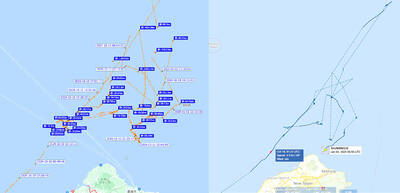Doctors found that a 56-year-old woman, who had for more than 10 years constantly felt pain in her hands, to the point that she could no longer hold chopsticks anymore, had vitamin C and vitamin D deficiencies.
Chen Jen-yin (陳貞吟), director of the Anesthesia Department and Pain Management Division at Chi Mei Hospital in Tainan, described the case during the Taiwan Pain Society’s annual meeting and international conference in Tainan yesterday.
The patient had sometimes been unable to fall sleep due to the pain, but despite visiting several doctors and taking painkillers, it continued to affect her quality of life, Chen said.
Over the past year, it affected her so badly that she could no longer hold chopsticks or a broomstick, she added.
Chen said that the woman was diagnosed and began taking nutritional supplements, as well as receiving prolotherapy and rehabilitation treatments, and her symptoms were significantly reduced.
The woman is still being treated, she added.
According to data collected since 2013 from about 31,000 people who have received health exams at Chi Mei Hospital, about half of men and 68 percent of women had a vitamin D deficiency, but about 80 percent of the patients visiting the pain management division were vitamin D deficient, Chen said.
While only about 5 percent of those who had received health exams were vitamin C deficient, about half of chronic pain patients had a vitamin C deficiency, she said.
Chen said that people often forget the importance of eating fruit, which is an important source of vitamin C, and many people, especially women, are used to avoiding the sun and wearing sunscreen, which can result in reduced vitamin D production.
A vitamin D deficiency leads to reduced intestinal calcium absorption and poor muscle contraction, while a vitamin C deficiency is associated with a lower pain threshold, she said.
If people have trouble getting enough vitamin C and D from their diet, they should take a supplement, Chen said.

DEEPER REVIEW: After receiving 19 hospital reports of suspected food poisoning, the Taipei Department of Health applied for an epidemiological investigation A buffet restaurant in Taipei’s Xinyi District (信義) is to be fined NT$3 million (US$91,233) after it remained opened despite an order to suspend operations following reports that 32 people had been treated for suspected food poisoning, the Taipei Department of Health said yesterday. The health department said it on Tuesday received reports from hospitals of people who had suspected food poisoning symptoms, including nausea, vomiting, stomach pain and diarrhea, after they ate at an INPARADISE (饗饗) branch in Breeze Xinyi on Sunday and Monday. As more than six people who ate at the restaurant sought medical treatment, the department ordered the

A strong continental cold air mass and abundant moisture bringing snow to mountains 3,000m and higher over the past few days are a reminder that more than 60 years ago Taiwan had an outdoor ski resort that gradually disappeared in part due to climate change. On Oct. 24, 2021, the National Development Council posted a series of photographs on Facebook recounting the days when Taiwan had a ski resort on Hehuanshan (合歡山) in Nantou County. More than 60 years ago, when developing a branch of the Central Cross-Island Highway, the government discovered that Hehuanshan, with an elevation of more than 3,100m,

Taiwan’s population last year shrank further and births continued to decline to a yearly low, the Ministry of the Interior announced today. The ministry published the 2024 population demographics statistics, highlighting record lows in births and bringing attention to Taiwan’s aging population. The nation’s population last year stood at 23,400,220, a decrease of 20,222 individuals compared to 2023. Last year, there were 134,856 births, representing a crude birth rate of 5.76 per 1,000 people, a slight decline from 2023’s 135,571 births and 5.81 crude birth rate. This decrease of 715 births resulted in a new record low per the ministry’s data. Since 2016, which saw

SECURITY: To protect the nation’s Internet cables, the navy should use buoys marking waters within 50m of them as a restricted zone, a former navy squadron commander said A Chinese cargo ship repeatedly intruded into Taiwan’s contiguous and sovereign waters for three months before allegedly damaging an undersea Internet cable off Kaohsiung, a Liberty Times (sister paper of the Taipei Times) investigation revealed. Using publicly available information, the Liberty Times was able to reconstruct the Shunxing-39’s movements near Taiwan since Double Ten National Day last year. Taiwanese officials did not respond to the freighter’s intrusions until Friday last week, when the ship, registered in Cameroon and Tanzania, turned off its automatic identification system shortly before damage was inflicted to a key cable linking Taiwan to the rest of